Fluid art is an enchanting world of swirling colors and hypnotic patterns, brought to life by some incredibly talented artists. Hannah Collins shines with her use of everyday materials like house paints, making art accessible and vibrant. Jenelle Elizabeth's attention to detail guarantees seamless pours, while Briana Coleman emphasizes meticulous surface preparation for better results. Kari Hertzog's focus on authentic expression and Kelly Johnson's controlled environments prevent issues like cracking. Evgenia Suvorova masters fluid dynamics, Brittany Akers explores color theory, and Kristen Herrington balances vibrant compositions. Curious to know more about these creative minds and their unique techniques? There's quite a bit left to uncover!
Key Takeaways
- Hannah Collins innovatively uses house paints and promotes ethical originality in fluid art.
- Jenelle Elizabeth is known for meticulous paint preparation and advocating thorough mixing for uniform consistency.
- Briana Coleman emphasizes meticulous surface preparation and proper gesso application techniques for fluid art.
- Hannah Collins and Briana Coleman recommend Liquitex professional gesso for optimal paint adhesion and surface enhancement.
Hannah Collins
What makes Hannah Collins a standout in the fluid art community is her innovative use of house paints and cost-effective alternatives like tester pots to create vibrant, enchanting artworks.
Collins' artistic inspiration is deeply rooted in experimenting with unconventional materials, making her art accessible to a wider audience. Her approach not only democratizes art-making but also encourages budding artists to explore creativity without the constraint of expensive supplies.
Collins is a fervent advocate for copyright awareness, emphasizing the importance of originality and ethical practices in the art community. She inspires artists to draw inspiration from existing works without resorting to direct copying, fostering a culture of respect and innovation.
In addition to her materials, Collins is meticulous about preparing her canvases. She recommends using Liquitex professional gesso for its ability to enhance the painting surface, ensuring that each artwork has a solid foundation.
Her technique often involves silicone additives, like silicone spray and coconut oil, to create mesmerizing cell formations in her fluid art.
Through her teachings, Collins passionately shares the importance of thoroughly mixing paint for at least a minute to avoid clumps, ensuring a smooth and uniform application in fluid art projects.
Jenelle Elizabeth
Jenelle Elizabeth, a standout in the fluid art world, is celebrated for her meticulous attention to paint preparation.
She believes that thorough mixing for at least a minute is vital to achieving smooth, clump-free paints, which are fundamental for her stunning pours.
Thorough Paint Mixing
Thoroughly mixing paint for at least one minute is vital to achieving a uniform consistency and eliminating clumps that could compromise the final artwork. When working with fluid art, paint viscosity plays a significant role in how colors blend and interact on the canvas. Guaranteeing a consistent mixture of paint and pouring medium, typically at a 1:1 ratio, allows for smoother pours and more vibrant color blending.
Using a digital scale to measure paint accurately is highly recommended. This guarantees that each batch of paint maintains the same consistency, which is essential for achieving predictable results. Additionally, experimenting with various colors and additives during the mixing process can introduce exciting effects such as enhanced cell formation.
To help you understand, here's a handy table summarizing key aspects of thorough paint mixing:
| Aspect | Details | Tips |
|---|---|---|
| Mixing Time | At least one minute | Use a timer for precision |
| Paint to Medium Ratio | Typically 1:1 | Adjust as needed for effect |
| Measurement Tools | Digital scale for accuracy | Consistent results |
Experimenting with different mixing techniques, such as stirring or shaking, can also influence the behavior of the paint during the pouring process, leading to unique and intriguing fluid art pieces.
Clump-Free Paints
Guaranteeing clump-free paints, as emphasized by artist Jenelle Elizabeth, is paramount for achieving smooth and seamless applications in fluid art. When paints have clumps, they can cause unwanted textures and disrupt the fluid dynamics, making it hard to get that perfect, even flow.
One of the key factors in preventing clumps is understanding paint viscosity. Thinner paints flow more easily, reducing the risk of clumping, while thicker paints may require extra effort to mix properly.
To combat clumping, using house paints or tester pots can be a great alternative to traditional acrylics, provided they are mixed thoroughly. The mixing process should last at least one minute to guarantee all particles are evenly distributed.
Additives like Floetrol can also play a significant role in achieving a clump-free mixture. The benefits of using Floetrol include enhanced fluidity and smoother interactions between colors, making the whole painting process much more enjoyable.
Minute Mixing Technique
A critical component of achieving a flawless fluid art piece is the Minute Mixing Technique, which mandates at least one minute of thorough paint mixing to guarantee a clump-free consistency. Jenelle Elizabeth, a prominent figure in fluid art, underscores the importance of this practice. By dedicating at least sixty seconds to mixing, artists can achieve the ideal paint consistency that is essential for smooth, uninterrupted flow and impeccable color blending.
Using a digital scale for precise measurements of paint and pouring mediums can notably enhance the effectiveness of this technique. Accurate proportions guarantee that each component interacts harmoniously, leading to more vibrant and dynamic artwork.
The Minute Mixing Technique not only guarantees a clump-free mixture but also allows colors to blend more seamlessly, resulting in fluid art pieces that captivate the eye with their intricate patterns and vivid hues.
Practicing this technique diligently provides artists with a deeper understanding of paint properties, enabling them to make more informed artistic decisions. By integrating the Minute Mixing Technique into their creative process, artists can uplift their work, producing stunning pieces that reflect both technical proficiency and artistic vision.
Briana Coleman
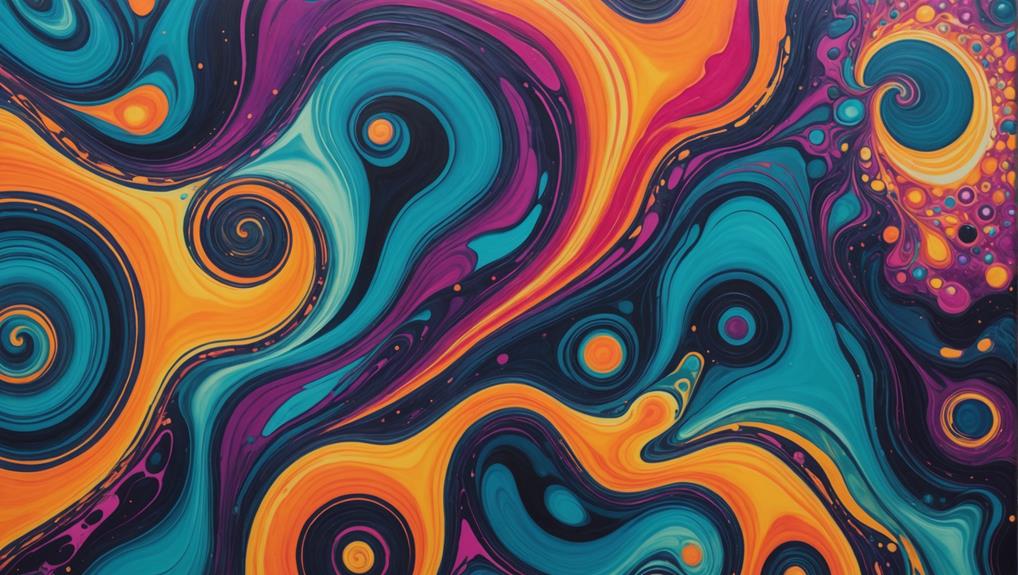
Briana Coleman stands out in the fluid art world with her focus on meticulous surface preparation and the use of Liquitex professional gesso, which she believes is key for achieving stunning results.
Her tips on priming surfaces and selecting the right art supplies have become invaluable to artists seeking to refine their techniques.
Essential Gesso Preparation
Proper preparation with gesso is fundamental for achieving a pristine and vibrant fluid art piece. Understanding the right gesso application techniques and gesso drying times is vital for artists aiming to perfect their craft. Gesso, a primer, guarantees better paint adhesion and enhances color vibrancy. Liquitex professional gesso is highly recommended for its smooth application and durable finish.
When applying gesso, it's important to use even strokes, making sure no area is left untreated. This step assures uniformity, which is essential for fluid art. Remember, patience is key; allowing gesso to dry fully before painting is non-negotiable. Gesso drying times can vary but typically, it takes about an hour for a single layer to dry. For increased opacity and texture, multiple layers can be applied, each requiring its own drying time.
Gesso can be applied to various surfaces, from canvas to wood and even paper, making it incredibly versatile. Here's a quick guide for applying gesso:
| Surface | Application Method | Drying Time |
|---|---|---|
| Canvas | Brush or roller | 1 hour |
| Wood | Brush | 1-2 hours |
| Paper | Foam brush | 30-45 minutes |
This preparation guarantees your fluid art will be vibrant and long-lasting.
Surface Priming Tips
For achieving ideal paint adhesion and durability in fluid art, utilizing effective surface priming techniques is vital. Proper surface preparation not only enhances the final appearance but also guarantees the longevity of your artwork. One of the most recommended methods involves the use of Liquitex professional gesso due to its superior properties.
Here are some key gesso techniques for peak surface preparation:
- Thin, Even Layer Application: Apply a thin and even layer of gesso to the surface to create a consistent texture. This step is essential to enhance paint flow and reduce absorption, leading to a more controlled pour.
- Complete Drying: Allow the gesso to dry completely before proceeding with your paint pour. This guarantees a solid base and prevents the paint from sinking or spreading unevenly, which can distort your design.
- Light Sanding: After the gesso has dried, lightly sand the surface. This creates a smoother finish, which not only makes the painting process easier but also enhances the overall appearance of the final piece.
Recommended Art Supplies
High-quality acrylic paints and pouring mediums are essential components for achieving superior fluid art results. When it comes to acrylic paint types, opting for professional-grade options guarantees you get better pigment and consistency. This means your colors will be more vibrant and your artwork will have a polished finish. Brands like Golden or Liquitex are popular choices among fluid artists.
Pouring medium options are equally important. These mediums help your paint flow smoothly and maintain their integrity without cracking. Floetrol is a favorite due to its ease of use and reliable results. Another great choice is Liquitex Pouring Medium, which is specifically designed to enhance the flow and flexibility of acrylic paints.
To add some exciting effects, you can use silicone additives like silicone oil or spray. These create cells and textures in your artwork, giving it depth and making it more interesting.
Don't forget about surface preparation! Applying a layer of gesso, such as Liquitex professional gesso, guarantees better paint adhesion and a smoother finish.
Kari Hertzog
Kari Hertzog distinguishes herself in the fluid art world through her unwavering commitment to authentic self-expression and meticulous attention to workspace preparation. Known for her fluid expression, Hertzog places considerable emphasis on reflecting personal feelings in her work, rather than adhering to external expectations. This dedication to personal connection is evident in each piece she creates, showcasing her unique artistic voice.
Hertzog's approach to fluid art isn't just about the emotional aspect; she also stresses the importance of a well-prepared workspace. Cleanliness and proper surface treatment are essential, she believes, to enhancing the overall quality of the artwork.
Regularly steps back from her work: Hertzog advises artists to step back frequently to gain perspective, helping to prevent overworking.
Focus on personal energy and spontaneity: She promotes creating art driven by personal energy, not deadlines or pressure.
Knowledge sharing: An influential figure, Hertzog shares her techniques, fostering a collaborative environment.
Workspace preparation: Emphasizes that a clean, well-prepared workspace notably improves the art's outcome.
Through her dedication to fluid expression and personal connection, Kari Hertzog continues to inspire and influence the fluid art community, encouraging artists to embrace their true selves in their creations.
Kelly Johnson
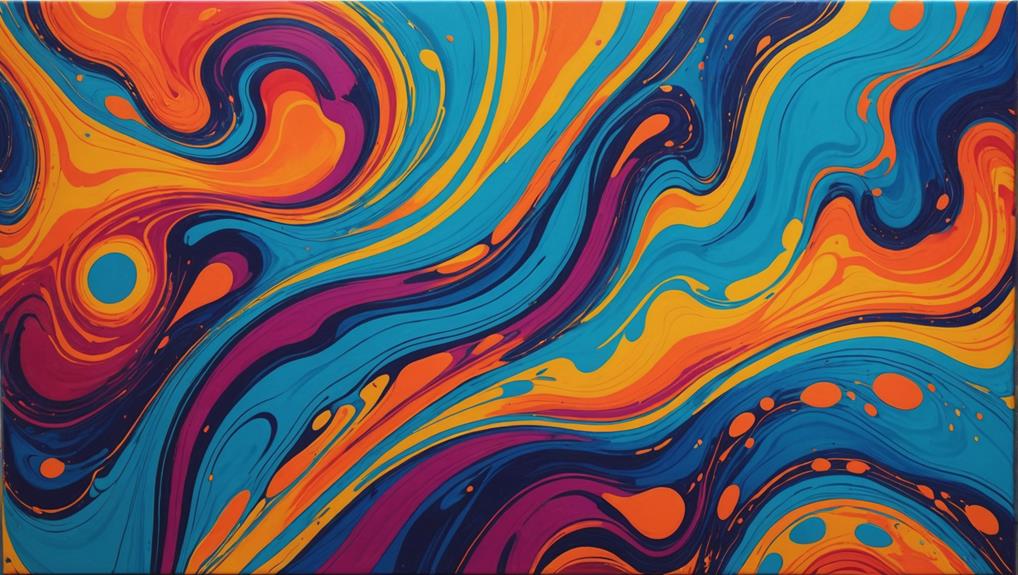
Kelly Johnson has garnered acclaim in the fluid art community for her meticulous approach to controlling the painting environment, guaranteeing ideal results and preventing common issues like cracking. Her expertise in fluid art techniques has made her a go-to source for artists enthusiastic to improve their craft.
Johnson emphasizes the importance of controlled environments during the painting process. She advises monitoring drying times closely and suggests painting in warmer, sheltered areas to achieve the best outcomes in fluid art projects. By doing so, artists can minimize the risk of cracking, a common issue that can ruin otherwise beautiful pieces.
Workspace preparation is another key focus for Johnson. She stresses that cleanliness and proper surface treatment can greatly enhance the quality of the final artwork. A clean workspace guarantees that no dust or debris interferes with the fluid paint, leading to smoother and more vibrant results.
Additionally, Johnson highlights the significance of avoiding breezy conditions during painting sessions. Wind can disrupt the fluid paint application, causing uneven patterns and unwanted textures. Her practical tips and techniques are widely shared in the fluid art community, helping both beginners and experienced artists improve their craft.
Evgenia Suvorova
Evgenia Suvorova has revolutionized fluid art with her innovative use of silicone additives to enhance cell formation in her paintings. Known for her pioneering techniques, Suvorova's methods have set a new standard in the fluid art community. Her approach emphasizes the significance of experimentation, encouraging artists to explore different additives and methods to achieve striking and unique results.
Suvorova's techniques are notable for their focus on fluid dynamics, which allows for an enthralling interplay of colors and textures in her work. This mastery of paint properties is evident in her art, where the dynamic interaction of hues and patterns creates mesmerizing visual effects.
Her contributions to the field are not just confined to her artwork. Suvorova actively shares her expertise through online tutorials, where she teaches essential techniques such as torching to improve cell visibility. Her engagement with the fluid art community is commendable, fostering collaboration and inspiring both beginners and seasoned artists alike.
Evgenia Suvorova's influence on the world of fluid art is undeniable, making her a pivotal figure in this ever-evolving artistic genre.
- Innovative use of silicone additives
- Emphasis on experimentation
- Mastery of fluid dynamics
Brittany Akers
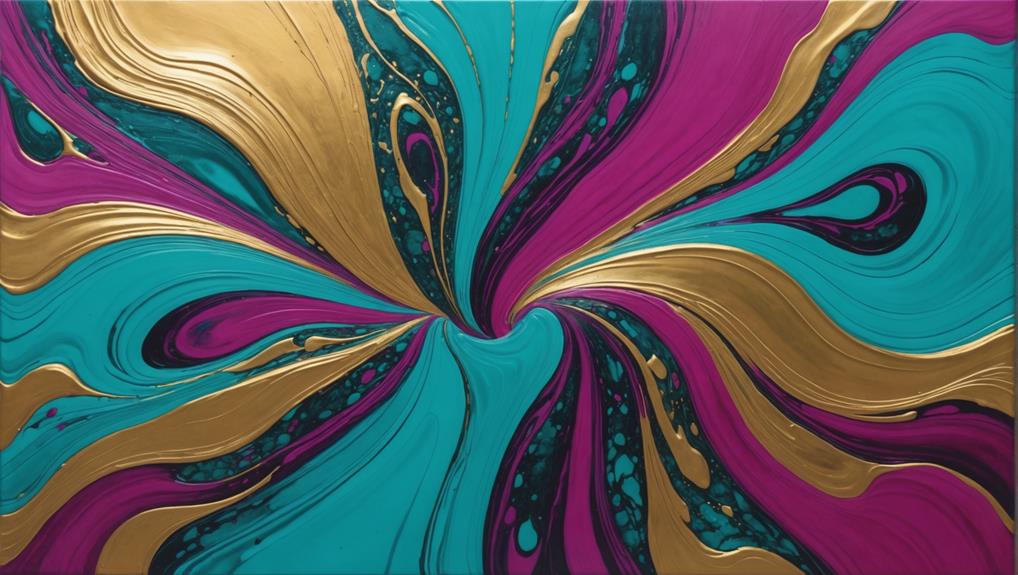
Brittany Akers stands out in the fluid art community for her innovative approach, which emphasizes the harmonious interplay of contrasting colors to achieve depth and balance in her compositions.
Her mastery of color theory allows her to create vibrant pieces that captivate the eye and spark the imagination. By skillfully combining opaque and transparent paints, Akers employs layering techniques that add a dynamic and complex dimension to her artwork.
Akers encourages artists to experiment with different color combinations, pushing the boundaries of traditional fluid art. She believes that understanding the principles of color theory can greatly enhance an artist's ability to create visually stunning pieces.
Her work often highlights the importance of transparency and opacity in paint properties, using these characteristics to produce unique visual effects that are both striking and mesmerizing.
Through various platforms, Brittany Akers shares her techniques and insights, inspiring a growing audience of fluid art enthusiasts. Her dedication to the craft and willingness to educate others have made her a beloved figure in the community.
Whether you are a seasoned artist or a beginner, Akers' approach to fluid art offers invaluable lessons on how to achieve balance, depth, and vibrancy in your creations.
Kristen Herrington
Kristen Herrington captivates the fluid art community with her vibrant compositions that skillfully balance color and movement. Renowned for her expertise in fluid dynamics and color theory, Herrington's work is a mesmerizing dance of hues and forms. She masterfully employs contrasting colors to create visually striking pieces that draw viewers in, making them feel like they are witnessing a living, breathing entity on canvas.
Herrington advocates for the use of opaque paints to enhance the luminosity of translucent layers, creating an illusion of depth. Her dedication to meticulous color planning guarantees that each piece achieves the desired artistic effect, showcasing her deep understanding of color theory.
Herrington's approach to fluid art is not merely technical but also profoundly personal. She encourages artists to embrace their authenticity, focusing on their personal energy rather than external pressures.
Key aspects of Herrington's techniques include:
- Opaque paints for enhanced luminosity: Creates depth by layering opaque and translucent paints.
- Careful color planning: Guarantees harmonious and balanced compositions.
- Authentic creative expression: Focuses on personal energy and genuine artistic vision.
Through her unique approach and dedication, Kristen Herrington has become an influential figure in the fluid art world.
Jennifer Krol
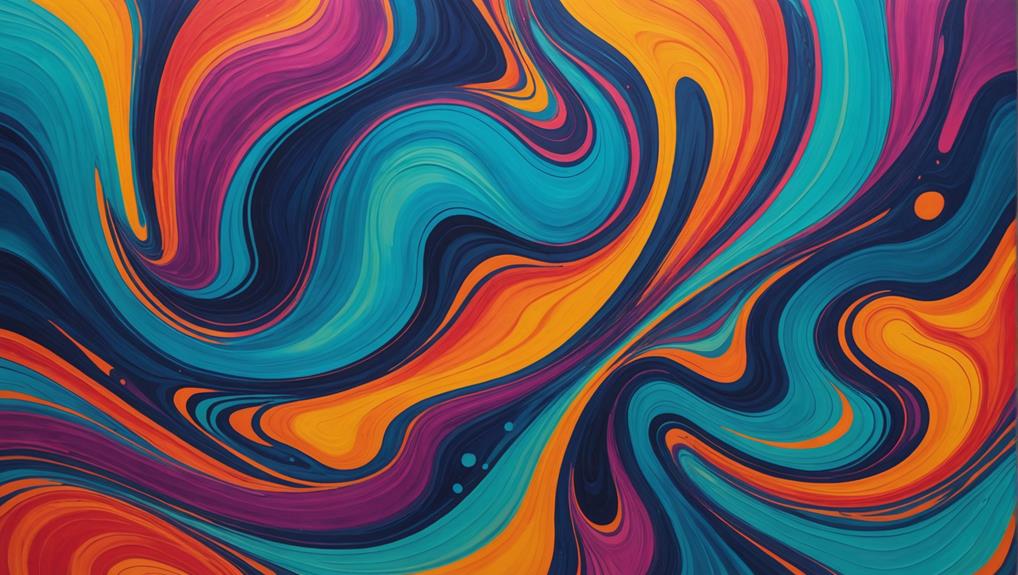
Jennifer Krol, a prominent figure in the fluid art community, is celebrated for her innovative use of color combinations and intricate layering techniques. Her approach to fluid art is all about careful planning to achieve the desired effects, making her pieces not just visually stunning but also deeply thoughtful.
One of the standout aspects of Krol's work is her mastery of color theory. She skillfully balances opaque and transparent paints, creating layers that give her work incredible depth and dimension.
Krol is a big advocate for authentic artistic expression, encouraging artists to create pieces that reflect their personal feelings instead of trying to meet external expectations. She believes this authenticity is what makes art truly powerful and resonant.
To enhance the vibrancy of her colors, Krol often applies a high gloss varnish once her artwork is dry, making the hues pop and adding a professional finish.
Beyond her own creations, Krol is committed to fostering skill development in the fluid art community. She shares her techniques and insights through workshops and online platforms, helping aspiring artists realize their potential.
Her contributions have made a significant impact, inspiring many to explore fluid art with renewed passion and confidence.
Frequently Asked Questions
Who Are the Famous Paint Pouring Artists?
Prominent paint pouring artists include Keri G. with her vibrant acrylic pours, Olga Soby's innovative fluid art techniques, Mixed Media Girl's beginner-friendly tutorials, and The Fluid Art Company known for unique methods and essential paint pouring supplies.
Who Was the First Fluid Artist?
David Alfaro Siqueiros is often recognized as the first fluid artist, pioneering fluid art techniques in the 1930s. His innovative use of industrial paints and exploration of fluid dynamics have had lasting historical influences on modern fluid art practices.
Who Discovered Fluid Art?
David Alfaro Siqueiros is credited with discovering fluid art through his innovative fluid art techniques in the 1930s. His concept of 'accidental painting' and emphasis on historical fluidity laid the foundation for contemporary fluid art.
Who Is the Artist Who Works With Water?
The artist renowned for her water art and aquatic creativity is Zaria Forman. She creates large-scale pastel drawings that capture the fluidity of water, aiming to raise awareness about climate change and the fragility of water ecosystems.
Conclusion
The world of fluid art is enriched by the remarkable contributions of artists like Hannah Collins, Jenelle Elizabeth, Briana Coleman, Kari Hertzog, Kelly Johnson, Evgenia Suvorova, Brittany Akers, Kristen Herrington, and Jennifer Krol.
Their innovative techniques and unique perspectives continue to shape and inspire this dynamic art form.
The exploration of their works offers profound insights into the limitless possibilities of fluid art, affirming its place as an enchanting and evolving artistic discipline.

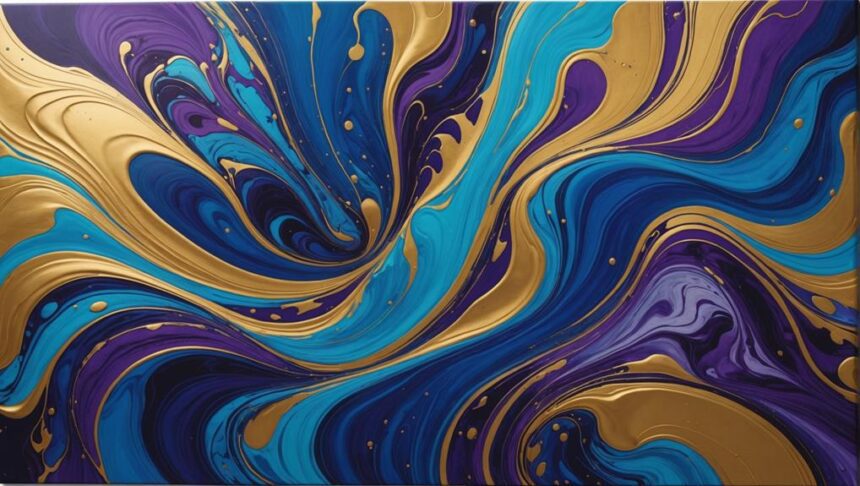
Leave a Reply